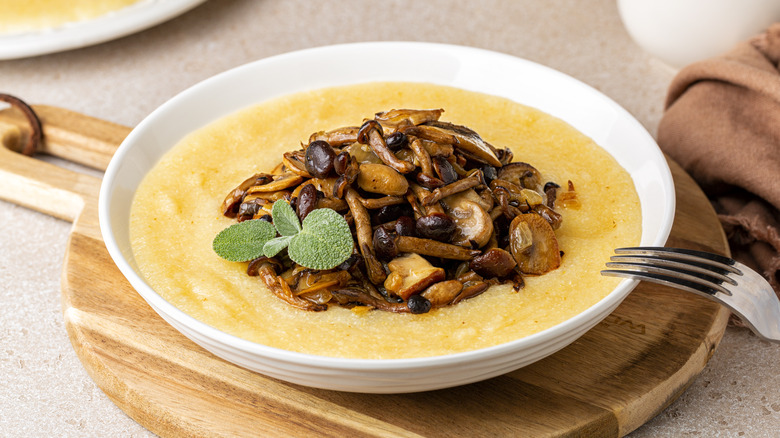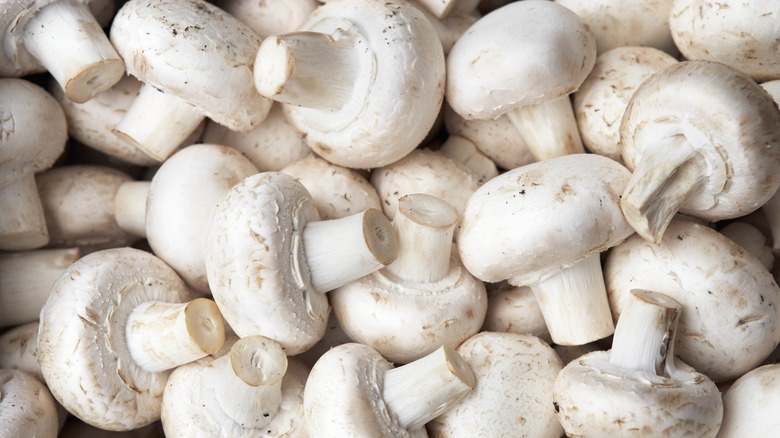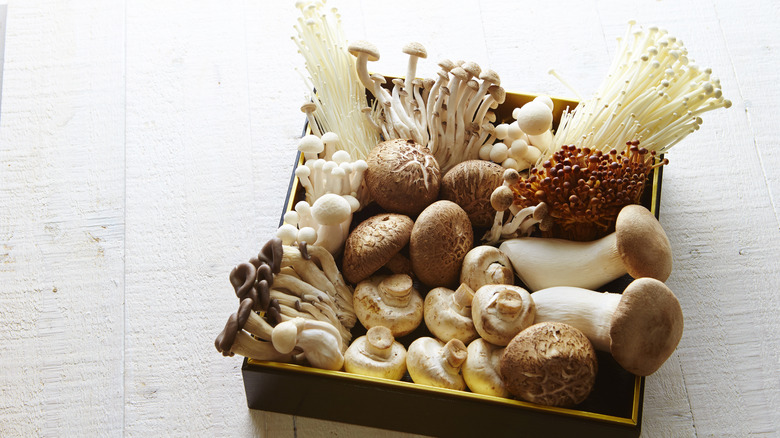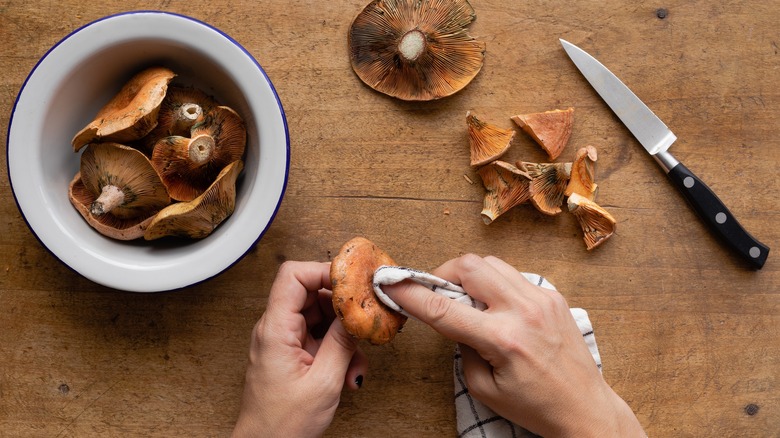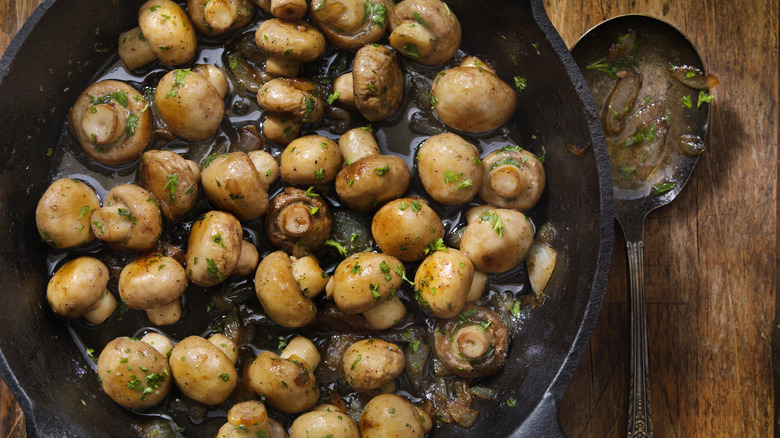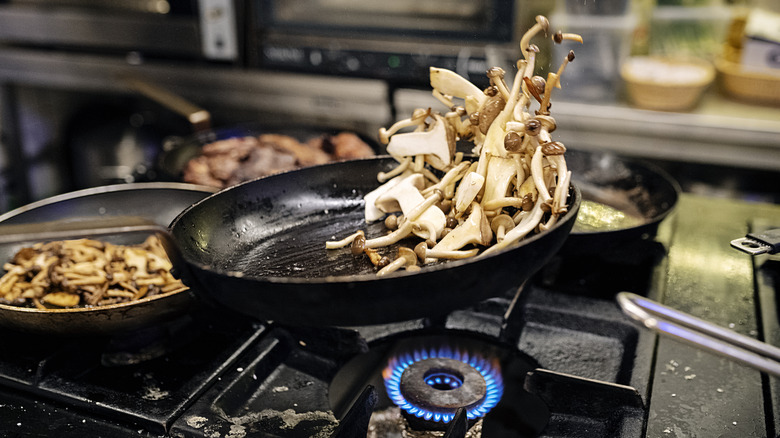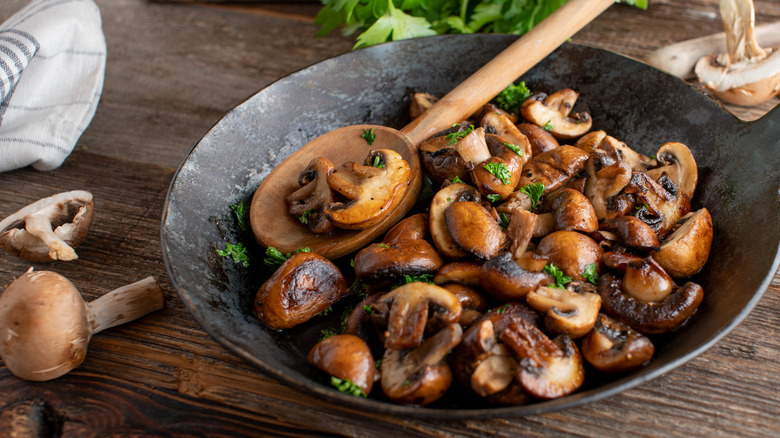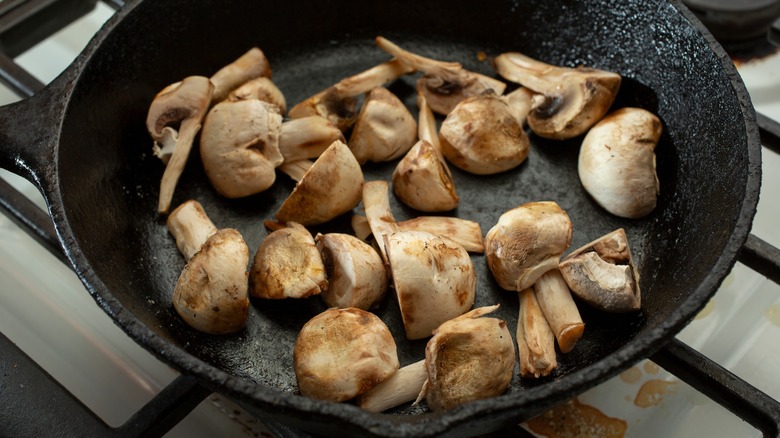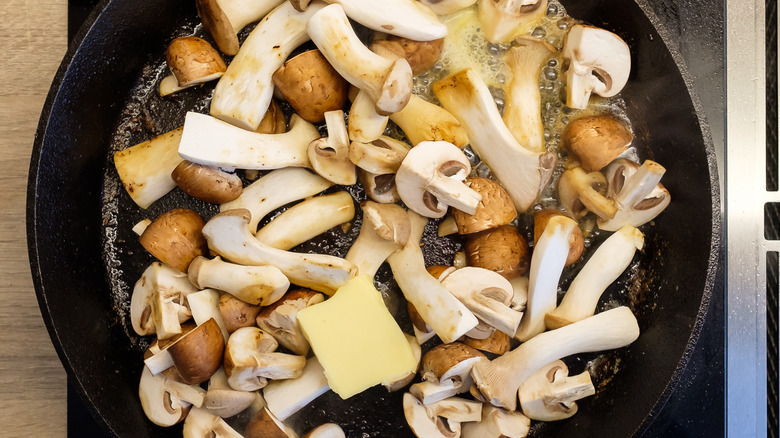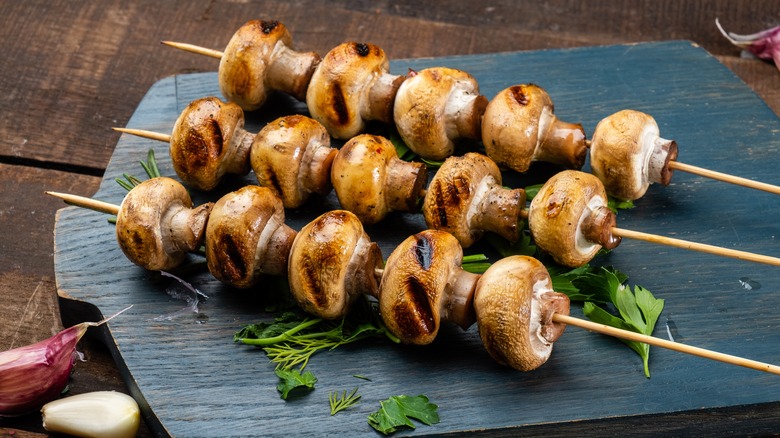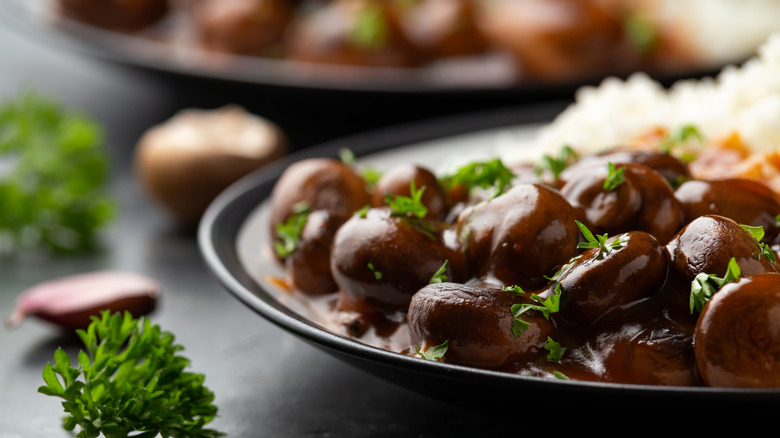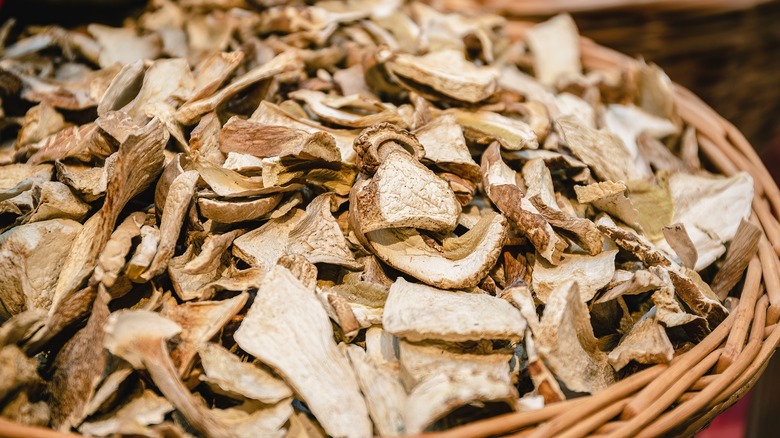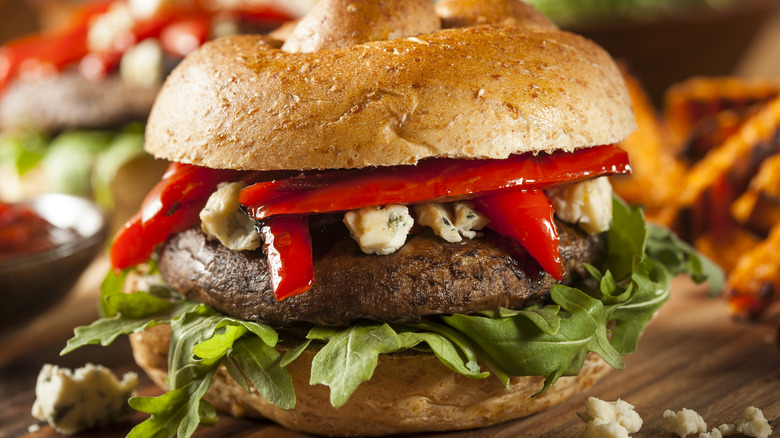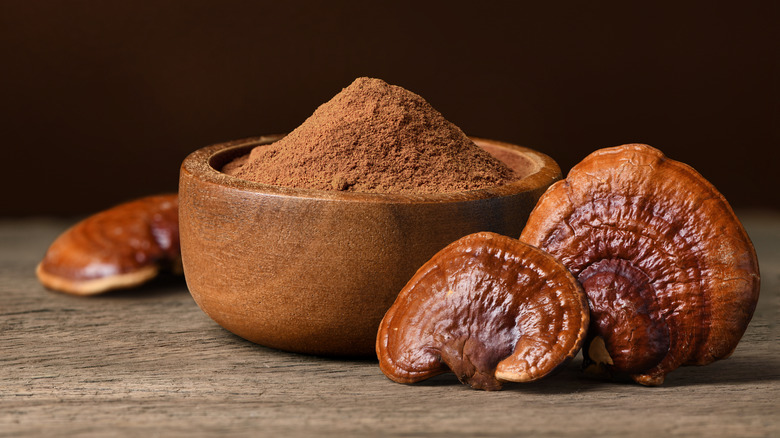This Is Why Mushrooms Taste Better At Restaurants
Have you ever wondered how human beings discovered which mushrooms are edible and which aren't? I sure have. As a mycophile and professional chef, I love thinking about, cooking, and eating mushrooms. What I love even more is serving them to guests who might otherwise think they dislike them. There's nothing more thrilling than converting someone who thought they hated mushrooms, only to discover they enjoy them when I cook them.
I'm not some kind of mushroom magician, but I have prepared my fair share of these fascinating fungi in my nearly 18 years as a chef. While I'm cognizant of the many mistakes people make when cooking mushrooms, what's more important are the special skills I and other chefs have developed when it comes to preparing them. For most people, this expertise and know-how often translates to mushrooms tasting infinitely better when they dine out at a restaurant than they do when prepared at home.
Because I am so fervent about fungi, I'm here to deliver the scoop on how chefs turn these spongy, spore-bearing sources of sustenance into savory delicacies sure to titillate even the most fickle taste buds. Read on for all the ways you can transform your favorite mushroom recipes into dishes fit for a five star fine dining experience.
They obtain the freshest mushrooms
When it comes to sourcing ingredients, restaurants always have an advantage in the freshness department. This is no different where mushrooms are concerned. Restaurants get regular deliveries of goods from restaurant suppliers, or, in the case of mushrooms, licensed mushroom hunters. The situation for home cooks is much more dire. The state of grocery store mushrooms is often sad. Most of the offerings are slimy, squishy, and smell like a locker room in a high school gymnasium. This is off-putting even for those of us who love mushrooms, and no chef worth their salt would go anywhere near these specimens, even for the most basic recipe.
Fresh mushrooms should be plump, dry, and have an earthy, grassy, almost sweet aroma. If you're able to flip them over and look at their gills, they should be clearly defined, not mushy or indistinguishable. The caps should be free of bruises, dents, or other imperfections that indicate they have been damaged. Moreover, while mushrooms are often packaged in containers that are encased in plastic, this is not the ideal way for them to be stored; it can trap moisture, causing the mushrooms to get slimy more rapidly. Mushrooms sold loose in bulk are often fresher and more flavorful.
They use a wide array of mushrooms
There are about 2,000 types of edible mushrooms, but odds are, you can only get your hands on a few basic varieties. This is another area where restaurants have a leg up over home cooks. Not only do their suppliers deliver fresh mushrooms, they have access to more species than most of us could ever dream of finding. The ability to source a variety of different types of fungi really opens up the possibilities when it comes to creating innovative and flavorful recipes.
Every species of mushroom has a unique shape, texture, aroma, and taste, making it more or less well-suited to certain dishes. While some mushrooms can safely and effectively be consumed raw, others should only be consumed when cooked. Chefs know this and can prepare distinct mushrooms in ways that are both safe and delicious. They are also able to effectively combine different types of mushrooms in creative ways, taking into account the specific characteristics of each that may help them play well off of each other in a recipe.
They know how to properly clean and prepare mushrooms
The topic of how to clean mushrooms can spark heated debate, even among professionals. While some swear that mushrooms should never be washed because they can easily become water-logged, others insist that they should at least be rinsed. While there is no hard and fast rule, whether or not you wash your mushrooms may depend as much on the specific variety you're working with as on anything else. Typically, cultivated mushrooms are less problematic than those foraged in the wild. When working with button mushrooms, for example, I often peel them after removing their stems. With other mushrooms that have a more firm cap, I may simply brush the tops of the mushroom clean using a damp cloth.
When it comes to mushrooms that have a lot of nooks and crannies, like morels, washing them becomes a necessity. The unusual honeycomb-shaped cap of a morel is notorious for retaining dirt, which can make them gritty when cooked if not properly cleaned. Once the mushrooms are brushed clean of excess dirt, they should be rinsed and soaked in a bowl of cold water for approximately 5 minutes. After cleaning, the morels should be impeccably dried by giving them a whirl in a salad spinner and then allowing them to air dry on a layer of paper towels.
They don't overcrowd the pan with mushrooms
While this rule applies to all vegetables, when it comes to mushrooms, not crowding them in a pan during the cooking process is doubly important. Mushrooms are almost entirely composed of water, making them incredibly susceptible to becoming squishy and gelatinous when too many are cooked at once. They require ample space for all that moisture to evaporate, allowing the sponge-like fungi to transform into a firm, meaty texture and to caramelize, developing rich, savory flavor. This is something chefs understand and implement, cooking mushrooms in smaller batches or using larger pans that are designed for high-heat commercial ranges.
While you can obtain these commercial pans for home use, it is likely that your home range is not designed to accommodate them, both in terms of size and the energy produced by each burner. Commercial ranges are often larger than home ones, and each burner typically emits up to 25,000 BTUs. Residential units range from 500 to 18,000 BTUs per burner. This is a significant difference and can directly impact the capacity of the home cook to replicate the results a restaurant can achieve when cooking mushrooms.
They aren't afraid to use high heat when cooking mushrooms
Speaking of BTUs and high-heat commercial ranges, another important factor which helps restaurant chefs stand apart from home cooks is using a hot enough temperature when preparing mushrooms. High heat allows for the Maillard reaction to commence, which transforms the sugars and amino acids within the mushrooms, allowing them to brown and develop an umami-rich aroma and flavor. It also encourages all of that excess water to evaporate, thereby giving mushrooms a more robust texture.
Mushrooms have a distinct scientific advantage over other foods when it comes to their capacity to withstand high heat. Beyond the insulating nature of their high moisture content, mushrooms are also loaded with a complex carbohydrate known as chitin. Chitin, which is also found in the outer shells of many insects and crustaceans, confers a protective layer upon mushrooms, which prevents them from burning. In fact, it allows them to stand up against temperatures as high as 716 degrees Fahrenheit. It is also responsible for many of the purported health benefits of mushrooms, including prebiotic and antioxidant properties. Savvy chefs know they can't overcook mushrooms, and set the flames to high.
They don't shy away from bold seasonings
When it comes to seasoning food, chefs aren't shy about adding fresh or dried herbs and spices. This is no less true when seasoning mushrooms: Doing so can enhance and temper their flavor. When it comes to their savory properties, sweeter spices often help accentuate their deliciousness. One of my favorite spices to use is freshly grated nutmeg. While it may be tempting to use pre-ground nutmeg, don't. The intensity of the real deal is infinitely more potent and will really help amplify the inherent characteristics of mushrooms.
Another seasoning that is necessary to both enhance the umami-rich qualities of mushrooms and temper their earthy, bitter notes is salt. Because of salt's ability to dehydrate foods, it may seem tempting to salt mushrooms at the beginning of the cooking process, but this would be a mistake. Salt can cause mushrooms to release their moisture too rapidly, resulting in the fungi steaming rather than caramelizing. The key is to salt mushrooms after they have been cooked. Doing so will also prevent them from becoming too salty. While kosher salt is always a good idea, try using a finishing salt with mushrooms, like fleur de sel or a smoked sea salt, for added complexity.
They dry sauté them
As I have already noted, mushrooms have an exceedingly high moisture content. Chefs know how to exploit this when it comes to preparing these fickle fungi. Though you can sauté them the way you would any vegetable — seasoned, in oil, over high heat — this may not be the ideal option for mushrooms, unless you're combining them with other vegetables. The best method to use is what is called a dry sauté. This cooking method will intensify the flavor of mushrooms while improving their texture, eliminating the sponginess and squishiness that often makes them unpalatable.
Dry sautéing involves tossing the cleaned and sliced mushrooms into a pan without any fat or seasoning after preheating it on high. The pan should be hot enough for a drizzle of water to sizzle in it before adding the mushrooms. Once the mushrooms have shrunk in size and begun to brown, they are ready to season with salt, pepper, and whatever spices or herbs you enjoy. This is also the time to add your choice of fat. Good quality butter is always delightful, as is a fruity olive oil. If you are unsure whether your mushrooms are ready for serving, rely on your nose. The aroma of the mushrooms will transform from something earthy to a distinctly nutty, savory smell, akin to a seared steak.
They use plenty of fat
I often discuss the joys of cooking with fat. It's one of the fundamentals taught to professional chefs. Fat doesn't just equal flavor, it equals aroma. This is even more true for mushrooms, which act like sponges, absorbing all that glorious fat. As fat soluble molecules are released by the addition of butter or olive oil, the inherent flavors and smells of the fungi are released, allowing them to make their way to your taste and olfactory receptors. This makes for a delicious experience.
The key is knowing what kind of fat to use and when to put it in. While you can sauté mushrooms in fat, depending on what kind you use, the fat may burn before the mushrooms have adequately released all of their moisture. It's better to toss the fat in toward the end of the cooking process. I typically add unsalted butter, extra virgin olive oil, or sesame oil right before removing the mushrooms from the heat, tossing them until they are thoroughly enveloped in the flavorful fat. If you really want to enhance the nuttiness of mushrooms cooked this way, I encourage you to use brown butter. The savoriness of brown butter will amplify the umami-richness of cooked mushrooms like nothing else can.
They use alternative cooking methods
While a dry sauté is a marvelous way to coax nutty flavors and aromas out of mushrooms, there are plenty of other cooking methods that are ideally suited to fungi. Restaurants are cognizant of this, and they like to switch things up, helping to infuse complexity into their menu ingredients. Grilling is always a good idea, as we know that mushrooms can tolerate intense heat, getting more flavorful as the Maillard reaction kicks in. Roasting is another method that works beautifully for mushrooms, though it takes a little finesse to do properly.
Before you begin roasting mushrooms, make sure they're not crowded on your baking sheet. Give them plenty of space for the hot air in the oven to circulate around them, which will help them caramelize. Another tip for helping them brown is draining off some of the liquid that has evaporated. Failure to do this will result in soggy, spongy mushrooms that stew in their own juices, rather than firming up. Lastly, add fat and seasonings after the mushrooms have roasted to perfection.
Restaurants that use sous vide immersion circulators will often pop mushrooms into a bag along with herbs and seasonings and cook them under a vacuum. The advantage of this is the concentration of mushroom flavor, though these fungi may need a quick sear in butter before being served, to help caramelize them and add much needed fat.
They infuse them with acid
One of the most common ingredients used in marinades and to deglaze the pan when cooking mushrooms is an acid of some kind. Chefs know that acids have the power to completely transform mushrooms. Not only can they add tang and brisk flavor, they can offset any lingering bitterness and amplify the inherent nuttiness and sweetness that emerge as mushrooms cook. They also tenderize them, helping them firm up more rapidly than mushrooms cooked without any acid.
Though you can use any type of acid, many chefs use lemon juice, balsamic vinegar, and/or white or red wine. One example of this is a classic Marsala sauce, which uses the fortified wine to deglaze the fond in the pan, giving the final sauce a savory richness that enhances any meat — or in this case, mushroom. When choosing a wine in which to cook mushrooms, you should always opt for one that is dry, not oaky, and has a generous amount of acidity, like a Pinot Grigio or a Merlot. Keep in mind, mushrooms will absorb the flavor and color of the wine, so choose accordingly depending on the final result you're looking for.
They incorporate dehydrated mushrooms
Dehydrated mushrooms are not just advantageous when fresh ones are unavailable, they have a marvelously concentrated flavor that can add intensity to a dish. We know that restaurant chefs are masters of layering flavors, seeking to maximize the earthy, umami, nutty notes of mushrooms every step of the way. Incorporating reconstituted dried mushrooms, and the liquid in which they have been rehydrated, is a masterful way of making a dish even more mushroom-y.
Speaking of that rehydrating liquid, while the standard is boiling water, there are a few alternative liquids that can pack even more flavor into these desiccated mushrooms, especially if the liquid is destined for incorporation into the final recipe. Stocks, broths, and wine are all great options for reconstituting dried fungi. They should be heated thoroughly before the dried mushrooms are fully submerged in the liquid. If you do opt for wine, keep in mind that those spongy mushrooms will absorb some of the alcohol. While some of this may evaporate during the cooking process, not all of it will. This may not be suitable for young diners, those who are pregnant or nursing, or anyone abstaining from drink.
They treat them like meat
There's a reason so many vegetarians and vegans rely on mushrooms for a satisfying meal. Their high levels of glutamate give them rich, umami-forward notes that are impressively meaty when properly cooked. This is a superpower of fungi that chefs use to their advantage. Not only are they often used to substitute meat in dishes, they can help amplify the savoriness of proteins like steak or pork chops.
That said, some mushrooms boast a meatier texture than others. Portobellos are the standard when it comes to making mock burgers because of their size and firm cooked texture. Other stand-outs are shiitakes, chanterelles, oysters, and maiitake mushrooms. When using mushrooms as a meat substitute for ground beef, it can be useful to add some cornstarch to the blend to ensure the moist fungi hold together properly. Remember, the best way to firm up those mushrooms and coax out their inherent meatiness is to cook them over high heat. Whether you sauté, grill, or roast them, this will encourage the moisture evaporation and browning that comes with the Maillard reaction.
They use them in different ways in the same dish
Just when you thought mushrooms couldn't get more versatile, I present you with a hack that chefs use to develop more complex, sophisticated flavor and texture. They transform mushrooms in multiple ways and pair them together on a plate. It's like a mushroom symphony, with each permutation of the fungi acting as a different musical instrument. Think of a cream of mushroom soup that is garnished with mushroom powder, roasted mushrooms, and a mushroom foam. It's an umami bomb of flavor, and a playful combination in terms of mouthfeel.
While some of these techniques are generally reserved for restaurant chefs who have the skill and chemicals to create things like foams and spheres, others are easily replicable by home cooks. I present you with mushroom powder, the secret ingredient you didn't know you needed. Mushroom powder is created by whizzing dehydrated mushrooms in a food processor or coffee grinder until they're completely pulverized. Though any kind of dried mushroom can be used, I prefer using a combination of different types for a more robust flavor. Mushroom powder can be sprinkled atop meat and vegetables for a boost of flavor. It can also be added to desserts as a garnish, for an earthy, savory contrast to all that sweetness.
